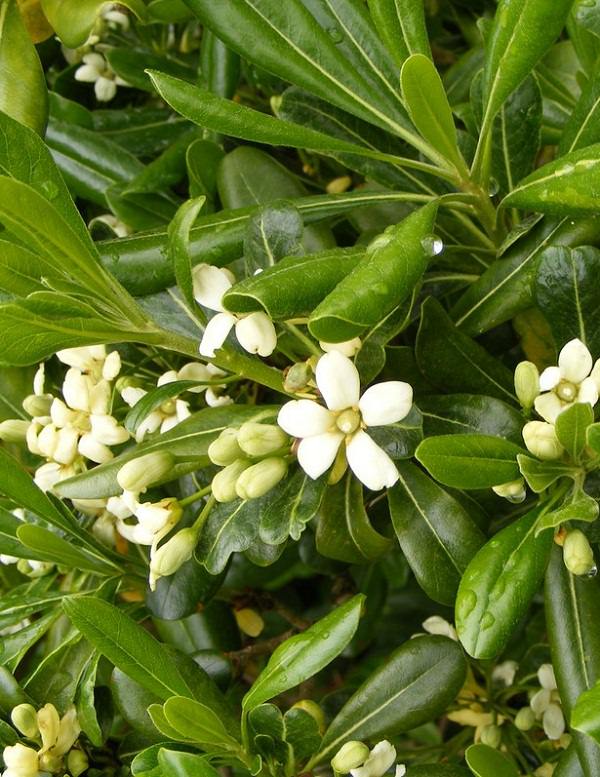Growing pittosporums and their care is easy. Not just scented flowers, they also reward with beautiful foliage. Their fast-growing ability makes them wonderful plants for hedges and borders!
Pittosporum is a genus of about 200 species of flowering shrubs and plants. The majority of these species are native to Japan and Southeast Asia, although several of them have been identified in Africa. The leaves of a Pittosporum plant are usually spiral or whorls. Most pittosporums do not exceed 2-3 meters in height after several years of steady growth. Growing pittosporum also allows enjoying its foliage, renowned for its beauty.
USDA Zones: 8-11
Difficulty: Easy
Other Names: Karo, Stiffleaf Cheesewood, Kaikaro, Kīhihi, Kōhūhū, Black Matipo, Kohukohu, Tawhiwhi, Japanese pittosporum, Japanese mock-orange, Australian laurel, and Japanese cheesewood.
What is Pittosporum

Pittosporums are evergreen plants that can be grown as a shrub or small tree. Pittosporum leaves are leathery, oval, alternate, bright, dark green in the light, and become lighter on the underside, with veins more or less evident depending on the variety.
Flowers are white, cream, yellow, red or brown, this too depends on the variety. These flowers are scented, emanating pleasant citrus-like fragrance.
Common Pittosporum Varieties
- Pittosporum tobira
- Pittosporum tenuifolium
- Pittosporum crassifolium
- Pittosporum eugenioides
Learn about the most fragrant flowering plants here
How to Grow Pittosporum
Propagation
You can propagate pittosporum plant by seeds, but growing pittosporum from cuttings is relatively easy and better. Our advice is to buy a plant from a nursery.
For this, take several cuttings of about 8 – 15 cm and plant them in a pot filled with starting mix. You can also dip them in rooting hormone before planting.
Place the cuttings on a bright spot and keep the soil moist. Once new leaves appear after a few weeks, slowly acclimate them, and when they have outgrown their existing pot, transplant them to a bigger pot or on the ground.
Planting Pittosporum
If your soil is heavy, dig a hole large enough (one meter in all directions) and mix 1/3 coarse sand, 1/3 compost and slow-release fertilizer in it. For planting in a pot, using a good quality light potting mix is optimal.
For a hedge, grow medium-sized varieties and space them about 1 m apart.
Carefully take out the plant from the pot without damaging the roots. Remove some soil around rootball gently and plant it at the same depth as it was grown previously. Water the plant thoroughly and regularly until it establishes.
Growing Pittosporum
Pittosporum plant is not difficult to grow. It is fast-growing and decorative. You can also plant it on your balcony or patio garden in a container.
Position
Pittosporums are fundamentally outdoor plants but can also be grown at home in the partial sun. Plant Pittosporum outside near a sheltered position so that it is not subjected to warm and cold currents or wind.
Watering
Keep the soil slightly moist. From the spring and all summer long, water abundantly but wait for the topsoil to dry out between watering spells, especially if you’re growing pittosporum in a pot.
Reduce watering in winter. Always remember that the pittosporum plant tolerates drought better than excessive irrigation, so avoid overwatering.
Soil
Soil should be well-drained, loamy, and slightly acidic to neutral in nature.
Pittosporum Care
Pittosporum care is simple, but if you’re growing it in a cooler zone, you should know its minimum temperature tolerance is variable, depending on the cultivar you’re growing.
Fertilizer
Feed the plant with a balanced slow-release fertilizer in spring. Follow label directions for dosage rates to avoid over-fertilization.
Mulching the plant in spring with composted leaves or aged manure is also beneficial.
Pruning
Pittosporum plant requires regular light trimming and pruning to remain in your desired shape, size, and appearance. Use sharp scissors to cut off damaged, dying, or diseased branches from the bush. If you want to do heavy pruning, do when its blooming period ends.
Pests and Diseases
No serious disease affects pittosporum plants but regularly inspect for pests like aphids, red spider mite, cushion scale, and pittosporum suckers.



very helpful information thank you.
Thank you for the info. We recently moved to a home that has a backyard abundant with pittosporum. Now we know more about it.
Our new house has several of these, giant specimens. Neighbor has some, too. Oh, the wonderful smell around the house outside over the past few weeks!
Is there a video on how to trim pittosporum so that it grows in a more narrow vertical space. I am growing against a white fence, but I spaced them separately so that I do not have a hedge….just wanted something a little more zen like….have them planted amongst rocks all around the base